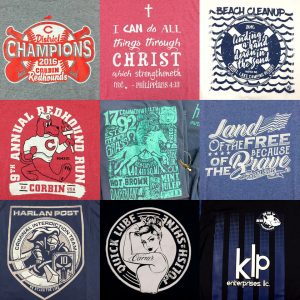There are two principal processes which require highlighting in apparel printing; those which deal with screen printing and embroidery. Screen printing is carried out on garments using a coated fabric that is stretched over a frame with a metallic image imprinted on it. When this is done, the fabric is lifted, pulled taut and then neatly pressed back into its original position. This operation is generally carried out by pressing rollers or a special type of press that has a roller or brush at the end.
 Digital printing on the other hand involves creating images using digital equipment. Two different methods are used for digital printing; offset printing and digital transfer printing. In case of offset printing, digital images are transferred directly from a digital image file onto a linen, usually cotton, garment. This transfer printing is usually a one-step process which requires several rolls of linen to be run for each image required.
Digital printing on the other hand involves creating images using digital equipment. Two different methods are used for digital printing; offset printing and digital transfer printing. In case of offset printing, digital images are transferred directly from a digital image file onto a linen, usually cotton, garment. This transfer printing is usually a one-step process which requires several rolls of linen to be run for each image required.
Embroidered Logos on the other hand involves utilising screen printing technology to create logos, names or texts on apparel using a t-shirt. The t-shirt printing technique can be done on garments using one or two types of garment materials. It is generally utilised for producing corporate logo printed emblems on company t-shirts, sweatshirts, golf tees and ball caps. This technique also involves the use of different colours. Blue, red and green shirts are some of the colours which can be used for embroidered logos.
The screen print technique is generally easier to implement and cheaper than the other two. However, the disadvantage of using screen printers is that the colours tend to fade with time and the image also suffers from smudging. In addition to these factors the image quality is also less clear than that produced by an embroidery machine. It is therefore important that you select a highly professional apparel printing for your business who can deliver excellent results using the latest equipment and technology.
The third transfer printing method utilises fabrics which have a reflective surface. The fabrics are woven onto a frame which has a substrate which has been specially printed with an image or text. The frame is then stitched together in a zigzag pattern, which is done according to the requirements of the customer. These garments are then finished off with the addition of ribbons and bows.
The three frequent questions asked by people who want to know more about this service include; how does screen print work; what are the different types of fabrics that can be used for this service and how are t-shirt printings created? The answer to the last question is very simple; screen printing works by using special coated fabrics which reflect light. The reflected light, which includes ultraviolet (UV) rays, helps in creating an image on the garment. This process is used to print t-shirts, sports uniforms, bandannas, caps and all other kinds of garments. For more details on printing and imaging visit https://www.littlerockprintingservices.com/.
 You have to utilize outdoor signage in order to capture your prospects market. Outdoor advertising allows you to reach more people at one time and at a reasonable cost. If you have limited budget, outdoor signage can help you build your business. If you are planning to start a business, you should invest your money in effective business signage.
You have to utilize outdoor signage in order to capture your prospects market. Outdoor advertising allows you to reach more people at one time and at a reasonable cost. If you have limited budget, outdoor signage can help you build your business. If you are planning to start a business, you should invest your money in effective business signage. If you are planning to change the look of your business signage, you can use different colors, logos, and fonts. However, you have to make sure that you are matching your business signage with the business. In addition to this, if you have a new shop, you can try out innovative ideas like custom business signage. You can also update your storefront signage by adding the latest technology like LED lights and solar power.
If you are planning to change the look of your business signage, you can use different colors, logos, and fonts. However, you have to make sure that you are matching your business signage with the business. In addition to this, if you have a new shop, you can try out innovative ideas like custom business signage. You can also update your storefront signage by adding the latest technology like LED lights and solar power.





 What are business signs? Simply put, they are anything that your potential customers may see or read on your property that could either help or hinder you as a business owner.
What are business signs? Simply put, they are anything that your potential customers may see or read on your property that could either help or hinder you as a business owner.  The next benefit of promotional material is that it is a tangible item that the recipient can hold in their hands. When you hand out business cards, they are often stuffed away somewhere or tucked under the table. However, promotional material tends to be more sturdy, which helps to prevent them from being tossed around. When you hand out a poster, people tend to remember your company. They may not see your business every day, but when they spot it on a shelf or on a table, they will instantly remember where you are and how you came to be.
The next benefit of promotional material is that it is a tangible item that the recipient can hold in their hands. When you hand out business cards, they are often stuffed away somewhere or tucked under the table. However, promotional material tends to be more sturdy, which helps to prevent them from being tossed around. When you hand out a poster, people tend to remember your company. They may not see your business every day, but when they spot it on a shelf or on a table, they will instantly remember where you are and how you came to be.